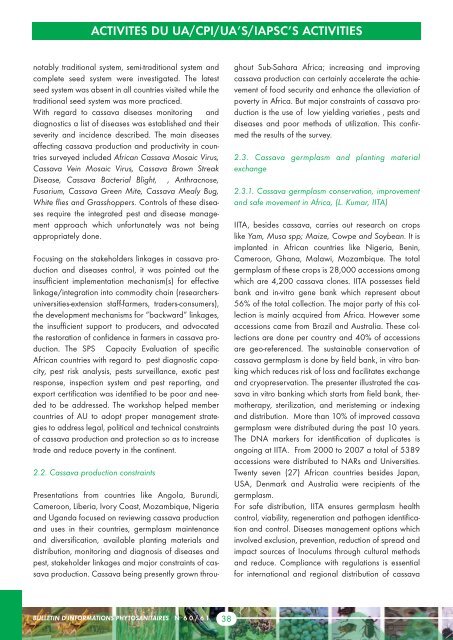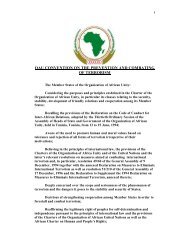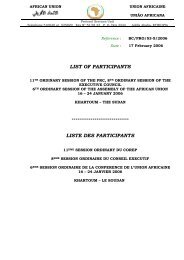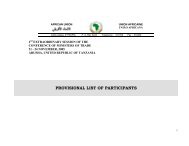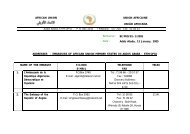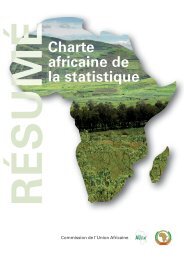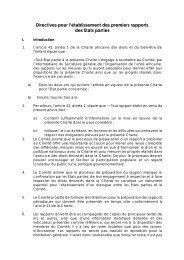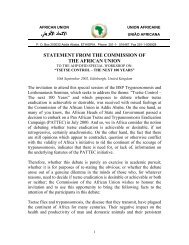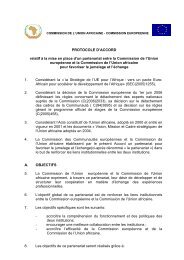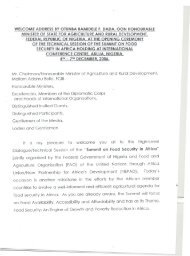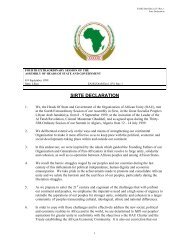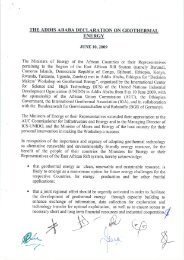BULLETIN D'INFORMATIONS PHYTOSANITAIRES ... - Union africaine
BULLETIN D'INFORMATIONS PHYTOSANITAIRES ... - Union africaine
BULLETIN D'INFORMATIONS PHYTOSANITAIRES ... - Union africaine
- No tags were found...
Create successful ePaper yourself
Turn your PDF publications into a flip-book with our unique Google optimized e-Paper software.
ACTIVITES DU UA/CPI/UA’S/IAPSC’S ACTIVITIESnotably traditional system, semi-traditional system andcomplete seed system were investigated. The latestseed system was absent in all countries visited while thetraditional seed system was more practiced.With regard to cassava diseases monitoring anddiagnostics a list of diseases was established and theirseverity and incidence described. The main diseasesaffecting cassava production and productivity in countriessurveyed included African Cassava Mosaic Virus,Cassava Vein Mosaic Virus, Cassava Brown StreakDisease, Cassava Bacterial Blight, , Anthracnose,Fusarium, Cassava Green Mite, Cassava Mealy Bug,White flies and Grasshoppers. Controls of these diseasesrequire the integrated pest and disease managementapproach which unfortunately was not beingappropriately done.Focusing on the stakeholders linkages in cassava productionand diseases control, it was pointed out theinsufficient implementation mechanism(s) for effectivelinkage/integration into commodity chain (researchersuniversities-extensionstaff-farmers, traders-consumers),the development mechanisms for “backward” linkages,the insufficient support to producers, and advocatedthe restoration of confidence in farmers in cassava production.The SPS Capacity Evaluation of specificAfrican countries with regard to pest diagnostic capacity,pest risk analysis, pests surveillance, exotic pestresponse, inspection system and pest reporting, andexport certification was identified to be poor and neededto be addressed. The workshop helped membercountries of AU to adopt proper management strategiesto address legal, political and technical constraintsof cassava production and protection so as to increasetrade and reduce poverty in the continent.2.2. Cassava production constraintsPresentations from countries like Angola, Burundi,Cameroon, Liberia, Ivory Coast, Mozambique, Nigeriaand Uganda focused on reviewing cassava productionand uses in their countries, germplasm maintenanceand diversification, available planting materials anddistribution, monitoring and diagnosis of diseases andpest, stakeholder linkages and major constraints of cassavaproduction. Cassava being presently grown throughoutSub-Sahara Africa; increasing and improvingcassava production can certainly accelerate the achievementof food security and enhance the alleviation ofpoverty in Africa. But major constraints of cassava productionis the use of low yielding varieties , pests anddiseases and poor methods of utilization. This confirmedthe results of the survey.2.3. Cassava germplasm and planting materialexchange2.3.1. Cassava germplasm conservation, improvementand safe movement in Africa, (L. Kumar, IITA)IITA, besides cassava, carries out research on cropslike Yam, Musa spp; Maize, Cowpe and Soybean. It isimplanted in African countries like Nigeria, Benin,Cameroon, Ghana, Malawi, Mozambique. The totalgermplasm of these crops is 28,000 accessions amongwhich are 4,200 cassava clones. IITA possesses fieldbank and in-vitro gene bank which represent about56% of the total collection. The major party of this collectionis mainly acquired from Africa. However someaccessions came from Brazil and Australia. These collectionsare done per country and 40% of accessionsare geo-referenced. The sustainable conservation ofcassava germplasm is done by field bank, in vitro bankingwhich reduces risk of loss and facilitates exchangeand cryopreservation. The presenter illustrated the cassavain vitro banking which starts from field bank, thermotherapy,sterilization, and meristeming or indexingand distribution. More than 10% of improved cassavagermplasm were distributed during the past 10 years.The DNA markers for identification of duplicates isongoing at IITA. From 2000 to 2007 a total of 5389accessions were distributed to NARs and Universities.Twenty seven (27) African countries besides Japan,USA, Denmark and Australia were recipients of thegermplasm.For safe distribution, IITA ensures germplasm healthcontrol, viability, regeneration and pathogen identificationand control. Diseases management options whichinvolved exclusion, prevention, reduction of spread andimpact sources of Inoculums through cultural methodsand reduce. Compliance with regulations is essentialfor international and regional distribution of cassava<strong>BULLETIN</strong> D’INFORMATIONS <strong>PHYTOSANITAIRES</strong> N OS 60/6138


